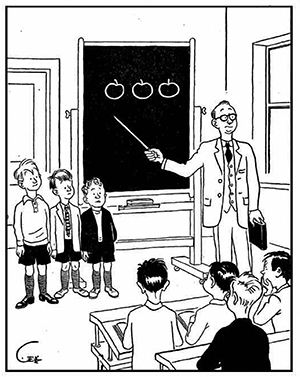100 YEARS AGO:Local elections bring proportional representation to Ireland
Published in Issue 1 (January/February 2020), Volume 28By Joseph E.A. Connell Jr

Above: ‘Three boys, three apples. Under PR, each boy gets an apple. Under first-past-the-post, the biggest boy gets the lot’—PR explained in Dublin Opinion, May 1959.
In the general election of December 1918 the newly re-formed Sinn Féin party had secured a large majority of seats (73 out of 105, or 69.5%) with only 46.9% of the vote (albeit 25 of those seats were uncontested) because of the ‘first-past-the-post’ electoral system. This provided a propaganda coup for Sinn Féin and so in response the British government introduced the Local Government of Ireland Act (1919), which allowed for elections by proportional representation (PR) in Ireland. The government hoped that the new system would reveal less-than-monolithic support for Sinn Féin.
The Proportional Representation Society of Ireland had been founded on 20 April 1911 in Dublin following a visit to Ireland by Leonard Courtney, 1st Baron Courtney of Penwith, who advocated proportional representation as an answer to the political problems faced in Ireland at the time. The Society was initially a branch of its sister organisation in Britain and its foundation was welcomed by several notable Irish politicians, including Arthur Griffith, who saw it as a way of ensuring that both unionists and nationalists were fairly represented in Ireland once it had Home Rule. The electoral system endorsed by the Society was the single transferable vote (STV) combined with the quota counting method in multi-seat constituencies. Griffith used his considerable influence to ensure that Sinn Féin adopted PR/STV as official policy. Largely as a result of the work done by the Proportional Representation Society of Ireland, the system was embodied in the third Home Rule Bill (1912).
The Society maintained its activity and PR/STV was first used in January 1919 for a local election to Sligo Corporation (see HI 17.3, May/June 2009, pp 38–9). As it was the first municipal election in the UK to employ the system, it attracted great interest from all over Britain and Ireland. The Sligo Champion declared that ‘the system has justified its adoption … and it is absolutely fair’. The Sligo Independent proudly stated that ‘Sligo has the honour of being the first municipality in Ireland to adopt the principle, and everyone agrees that it was a great success’. Dublin-based newspapers were equally impressed. The Irish Times argued that the election ‘has established beyond dispute two big things in favour of proportional representation. The first is that it is a thoroughly workable system … The other big thing—and it is really big—is the proof that in proportional representation we have the Magna Charta of political and municipal minorities.’ The Freeman’s Journal praised the fairness of the new system, saying that ‘the first elections, on the principle of proportional representation by the single transferable vote, have resulted in the fair representation of all parties’.
The system was first tested nationwide in the local elections of 1920. In the borough and urban district council elections in January Sinn Féin gained control of ten of the twelve boroughs in Ireland. Only Belfast and Derry remained respectively under Unionist or Irish Parliamentary Party control. In the rural elections in June, Sinn Féin took control of 338 out of 393 local government bodies, county councils, boards of guardians and rural district councils, albeit virtually no contests occurred outside Ulster.
This electoral system introduced by the 1919 Act is still used in Irish elections today.
Joseph E.A. Connell Jr is the author of The shadow war: Michael Collins and the politics of violence (Wordwell Books).
















